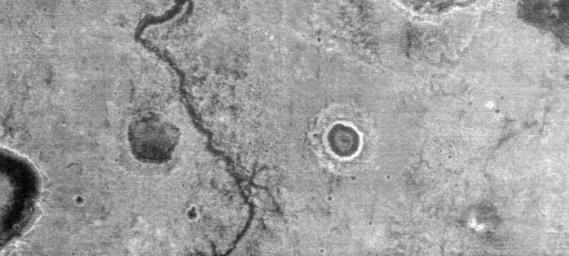Channel at Night in Thermal Infrared
Caption:
This nighttime thermal infrared image, taken by the thermal emission imaging system on NASA's 2001 Mars Odyssey spacecraft, shows differences in temperature that are due to differences in the abundance of rocks, sand and dust on the surface. Rocks remain warm at night, as seen in the warm (bright) rim of the five kilometer (three mile) diameter crater located on the right of this image.
The sinuous channel floor is cold, suggesting that it is covered by material that is more finely grained than the surrounding plains. The interior of the crater shows a great deal of thermal structure, indicating that the distribution of rocks, sand and dust varies across the floor.
The presence of rocks on the rim and inner wall indicates that this crater maintains some of its original character, despite erosion and deposition by Martian winds. Nighttime infrared images such as this one will greatly aid in mapping the physical properties of Mars' surface.
This image is centered at 2 degrees north, 0.4 degrees west, and was acquired at about 3:15 a.m. local Martian time. North is to the right of the image.
Background Info:
NASA's Jet Propulsion Laboratory manages the 2001 Mars Odyssey mission for NASA's Office of Space Science, Washington, D.C. The thermal emission imaging system was provided by Arizona State University, Tempe. Lockheed Martin Astronautics, Denver, is the prime contractor for the project, and developed and built the orbiter. Mission operations are conducted jointly from Lockheed Martin and from JPL, a division of the California Institute of Technology in Pasadena.
Cataloging Keywords:
| Name |
Value |
Additional Values |
| Target |
Mars |
|
| System |
|
|
| Target Type |
Planet |
|
| Mission |
2001 Mars Odyssey |
|
| Instrument Host |
Mars Odyssey |
|
| Host Type |
Orbiter |
|
| Instrument |
Thermal Emission Imaging System (THEMIS) |
|
| Detector |
|
|
| Extra Keywords |
Crater, Dust, Grayscale, Infrared, Thermal |
| Acquisition Date |
|
| Release Date |
2002-03-01 |
| Date in Caption |
|
|
| Image Credit |
NASA/JPL/Arizona State University |
| Source |
photojournal.jpl.nasa.gov/catalog/PIA03482 |
| Identifier |
PIA03482 |

 Planetary Data System
Planetary Data System
